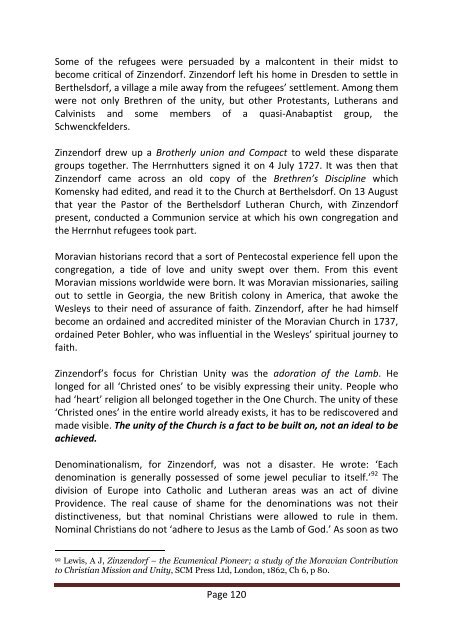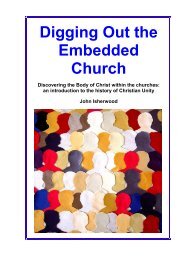Christian Unity (the book) - The Maranatha Community
Christian Unity (the book) - The Maranatha Community
Christian Unity (the book) - The Maranatha Community
Create successful ePaper yourself
Turn your PDF publications into a flip-book with our unique Google optimized e-Paper software.
Some of <strong>the</strong> refugees were persuaded by a malcontent in <strong>the</strong>ir midst tobecome critical of Zinzendorf. Zinzendorf left his home in Dresden to settle inBer<strong>the</strong>lsdorf, a village a mile away from <strong>the</strong> refugees’ settlement. Among <strong>the</strong>mwere not only Brethren of <strong>the</strong> unity, but o<strong>the</strong>r Protestants, Lu<strong>the</strong>rans andCalvinists and some members of a quasi-Anabaptist group, <strong>the</strong>Schwenckfelders.Zinzendorf drew up a Bro<strong>the</strong>rly union and Compact to weld <strong>the</strong>se disparategroups toge<strong>the</strong>r. <strong>The</strong> Herrnhutters signed it on 4 July 1727. It was <strong>the</strong>n thatZinzendorf came across an old copy of <strong>the</strong> Brethren’s Discipline whichKomensky had edited, and read it to <strong>the</strong> Church at Ber<strong>the</strong>lsdorf. On 13 Augustthat year <strong>the</strong> Pastor of <strong>the</strong> Ber<strong>the</strong>lsdorf Lu<strong>the</strong>ran Church, with Zinzendorfpresent, conducted a Communion service at which his own congregation and<strong>the</strong> Herrnhut refugees took part.Moravian historians record that a sort of Pentecostal experience fell upon <strong>the</strong>congregation, a tide of love and unity swept over <strong>the</strong>m. From this eventMoravian missions worldwide were born. It was Moravian missionaries, sailingout to settle in Georgia, <strong>the</strong> new British colony in America, that awoke <strong>the</strong>Wesleys to <strong>the</strong>ir need of assurance of faith. Zinzendorf, after he had himselfbecome an ordained and accredited minister of <strong>the</strong> Moravian Church in 1737,ordained Peter Bohler, who was influential in <strong>the</strong> Wesleys’ spiritual journey tofaith.Zinzendorf’s focus for <strong>Christian</strong> <strong>Unity</strong> was <strong>the</strong> adoration of <strong>the</strong> Lamb. Helonged for all ‘Christed ones’ to be visibly expressing <strong>the</strong>ir unity. People whohad ‘heart’ religion all belonged toge<strong>the</strong>r in <strong>the</strong> One Church. <strong>The</strong> unity of <strong>the</strong>se‘Christed ones’ in <strong>the</strong> entire world already exists, it has to be rediscovered andmade visible. <strong>The</strong> unity of <strong>the</strong> Church is a fact to be built on, not an ideal to beachieved.Denominationalism, for Zinzendorf, was not a disaster. He wrote: ‘Eachdenomination is generally possessed of some jewel peculiar to itself.’ 92 <strong>The</strong>division of Europe into Catholic and Lu<strong>the</strong>ran areas was an act of divineProvidence. <strong>The</strong> real cause of shame for <strong>the</strong> denominations was not <strong>the</strong>irdistinctiveness, but that nominal <strong>Christian</strong>s were allowed to rule in <strong>the</strong>m.Nominal <strong>Christian</strong>s do not ‘adhere to Jesus as <strong>the</strong> Lamb of God.’ As soon as two92Lewis, A J, Zinzendorf – <strong>the</strong> Ecumenical Pioneer; a study of <strong>the</strong> Moravian Contributionto <strong>Christian</strong> Mission and <strong>Unity</strong>, SCM Press Ltd, London, 1862, Ch 6, p 80.Page 120








